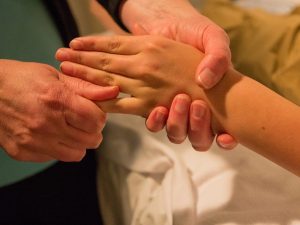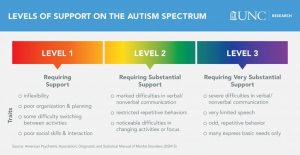Kristin Jerger Researches Qigong Sensory Training as Treatment for Children with Autism
April 6, 2018Endeavors
Kristin Jerger closes her eyes and draws several slow, deliberate breaths — in, out. In, out. Her soft breathing is the only sound in the room: a small space with white walls, warm lighting and a cushioned massage table in the center. She walks around the table slowly, lifting and lowering her hands like she does for all her massage sessions, to “get the ch’i going.”
A few minutes later, Jerger and another adult stand on either side of the table. The recipient of the massage lies stiffly on their stomach, hands at their side. She begins by patting them firmly on the crown of the head, describing the process of the massage as she moves down the spine, toward the legs and feet. The touch is firm, direct and produces a sort of dull vibration in its aftermath.
Throughout the 20-minute session, the subject relaxes: they move their feet, squirm a bit and lower their shoulders. The body language eases into calm rather than nervous and loose rather than stiff.
Massage is not new; many archaeologists believe that the practice is as old as some of the world’s earliest and most influential civilizations. Today, it’s hard to walk through a mall or airport without seeing some form of massage marketed for stress relief. So what makes this type of massage so remarkable?
It’s for children with autism.
A Healing Touch
In a dimly lit office tucked away in the UNC-Chapel Hill School of Medicine, Jerger drinks a cup of green tea as she discusses her research. She is in her final year as a postdoctoral fellow in the Program for Integrative Medicine, and her research focuses on using massage therapy to augment the treatment of children diagnosed with autism.
Countless misconceptions surround autism spectrum disorder. “From the outside looking in, it can be hard to understand how individuals with autism react to certain sensations or situations,” Jerger says. The families of people with autism and autism researchers sometimes feel like they’re trying to complete a puzzle they can’t fully see just yet.
“Most people probably don’t think of massage therapy as a medical treatment in the same way they think of medications,” Jerger adds. “But it actually affects our body’s neural and biochemical systems, the same systems affected by medications.”
A physician, psychiatrist, neuroscientist and certified massage therapist, Jerger specializes in Qigong (CHI-gong) Sensory Training (QST) massage, a technique adapted from a traditional Chinese practice similar to acupuncture that uses pressure in the form of massage to improve blood flow in the body.

Though the exact mechanism is debated, improved blood flow has been repeatedly shown to have significant positive effects on general health and wellness for a variety of patients, including stroke victims. Through her work with QST, Jerger seeks to bridge Eastern understandings of health and medicine with Western research and perspectives on the practice. “I think of QST in the same way as medication, and use similar methods to investigate it,” Jerger says.
Adapting from a previous study that showed significant results, Jerger and a team of researchers at Carolina recently tested the feasibility of the effects of QST on 20 children with autism between the ages of four and seven. The results were exciting; children who took part in a single 90-minute massage therapy session demonstrated significantly higher responsiveness in the prefrontal cortex (PFC), the part of the brain in charge of complex cognitive functions like social behaviors, personality development and decision making. The PFC is thought by many scientists to be a center for unusual activity in individuals with autism.
This higher responsiveness was demonstrated during instances of heightened emotional reactions. The children in the study were shown pictures of faces expressing certain emotions both before and after the massage. Prior to the treatment, the children showed little to no response to expressions. But afterward, their responses were much more visceral — many children reacted with unease to sad or angry faces. Some even started to vocalize and cry.
“It’s truly unique,” Jerger notes. “The massage seems to act as a kind of white noise that helps kids’ brains recalibrate and make those emotional connections they otherwise wouldn’t.”
Working with Energy
Ch’i or qi is a Chinese word which literally translates to “breath,” but is figuratively understood to mean “energy” or “life force.” In traditional Chinese medicine, a balance of one’s own qi is considered essential for health. Qigong, the practice of working with qi, uses coordinated body posture and motion to promote a balance of qi in the body. Thus, Qigong massage aims to work with energy flow in the body for the purpose of healing.
Jerger trained as a physician, psychiatrist and neuroscience researcher before receiving her massage therapist certification from the Body Therapy Institute in Siler City, North Carolina in 2011. So what prompted the shift of focus?
“I had twins,” Jerger says. “They have some sensory issues, and I could see how a certain kind of touch was helpful to them. It reminded me how incredibly important touch is, and how it was almost completely left out of my medical training. I wanted to bring that touch, that energy, into our treatment in a professional way.”
As a medical practitioner, Jerger had previous experience working with children diagnosed with autism. With her added training in massage therapy, she began to recognize the potential of massage to help these kids. “I thought to myself: Who has already done this? I don’t need to recreate the wheel.”
In searching for options, Jerger discovered the Qigong Sensory Training Institute in Salem, Oregon. It was founded in 2008 by Dr. Louisa Silva, a lead researcher in interventions for children with autism and other developmental disorders, who worked with a traditional Chinese medicine teacher to craft a protocol specifically for children with autism. Her many published studies reveal astounding results: children with autism who receive Qigong massage treatment over a 20-week period have significant improvement in social skills and self-regulatory behaviors, including emotional and behavioral control. Some children even demonstrated a permanent move one full level down the hierarchy of the autism spectrum.

The best part? Qigong massage is cheap to learn, extremely teachable and accessible to parents of children with autism.
“Parents spend an average of $17,000 a year to care for their children with autism,” Jerger says. “QST massage doesn’t require anything but the parents’ hands.” The cost of learning how to administer QST falls between $1000 and $2000, which involves 20 sessions with a certified therapist like Jerger, who walks them through the process of the massage step-by-step.
“But after those 20 weeks, parents do quite well on their own,” Jerger says. “They ‘own’ the massage, you might say.” Parents who participated in Jerger’s study reported changes in behavior after just one massage, but for continued advances at a faster pace, the massage must be administered daily.
So what risks does the massage carry?
“None that I know of,” Jerger says. “They just might not like it, and then you stop.”
The exciting part
The results are there. But what exactly is the mechanism? That’s what Jerger wants to focus on in the next phase of her research. “To me, it seems like the therapy is temporarily holding off some process that’s getting in the way of their development,” she says. “That’s why you have to do it every day, because it wears off.”
Markers like improved heart rate variability and prefrontal cortex responsiveness could indicate some trends, according to Jerger. These variables are widely considered to be excellent indicators of general health. But with such a small sample size, it’s difficult to make hard and fast conclusions just yet.
“I just want parents to realize how helpful this treatment can be,” Jerger says. “Other folks have established that QST works. My job is to figure out how, and that’s the exciting part.”
Kristin Jerger is a physician and licensed massage therapist currently working as a postdoctoral research fellow in the Department of Physical Medicine and Rehabilitation’s Program on Integrative Medicine within the UNC School of Medicine.
